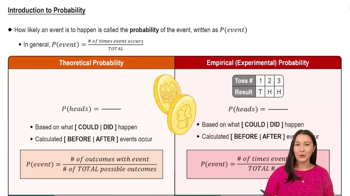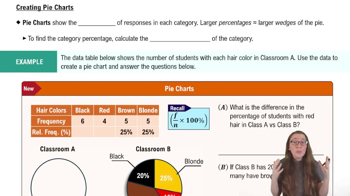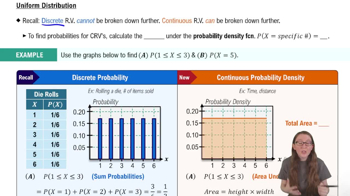28. A sample of 6500 automobiles found that 1560 of the automobiles were black, 3120 of the automobiles were sedans, and 1170 of the automobiles were black sedans. Find the probability that a randomly chosen automobile from this sample is black or a sedan.
Table of contents
- 1. Intro to Stats and Collecting Data1h 14m
- 2. Describing Data with Tables and Graphs1h 55m
- 3. Describing Data Numerically2h 5m
- 4. Probability2h 16m
- 5. Binomial Distribution & Discrete Random Variables3h 6m
- 6. Normal Distribution and Continuous Random Variables2h 11m
- 7. Sampling Distributions & Confidence Intervals: Mean3h 23m
- Sampling Distribution of the Sample Mean and Central Limit Theorem19m
- Distribution of Sample Mean - Excel23m
- Introduction to Confidence Intervals15m
- Confidence Intervals for Population Mean1h 18m
- Determining the Minimum Sample Size Required12m
- Finding Probabilities and T Critical Values - Excel28m
- Confidence Intervals for Population Means - Excel25m
- 8. Sampling Distributions & Confidence Intervals: Proportion1h 12m
- 9. Hypothesis Testing for One Sample3h 29m
- 10. Hypothesis Testing for Two Samples4h 50m
- Two Proportions1h 13m
- Two Proportions Hypothesis Test - Excel28m
- Two Means - Unknown, Unequal Variance1h 3m
- Two Means - Unknown Variances Hypothesis Test - Excel12m
- Two Means - Unknown, Equal Variance15m
- Two Means - Unknown, Equal Variances Hypothesis Test - Excel9m
- Two Means - Known Variance12m
- Two Means - Sigma Known Hypothesis Test - Excel21m
- Two Means - Matched Pairs (Dependent Samples)42m
- Matched Pairs Hypothesis Test - Excel12m
- 11. Correlation1h 6m
- 12. Regression1h 50m
- 13. Chi-Square Tests & Goodness of Fit1h 57m
- 14. ANOVA1h 57m
4. Probability
Addition Rule
Problem 3.3.19a
Textbook Question
U.S. Age Distribution The projected percent distribution of the U.S. population for 2025 is shown in the pie chart. Find the probability of each event. (Source: U.S. Census
Bureau)
a. Randomly selecting someone who is under 10 years old

 Verified step by step guidance
Verified step by step guidance1
Step 1: Understand the problem. The goal is to find the probability of randomly selecting someone who is under 10 years old from the U.S. population distribution for 2025. The pie chart provides the percentage distribution of different age groups.
Step 2: Identify the relevant data. From the pie chart, the percentage of the population under 10 years old is given as 12.1%. This percentage represents the proportion of the population in this age group.
Step 3: Convert the percentage to a probability. Probability is expressed as a decimal or fraction. To convert the percentage to a decimal, divide the percentage by 100. For example, \( P(\text{Under 10 years old}) = \frac{12.1}{100} \).
Step 4: Interpret the result. The probability represents the likelihood of randomly selecting someone under 10 years old from the population. Ensure the decimal value is between 0 and 1, as probabilities must fall within this range.
Step 5: Verify the calculation. Double-check the conversion and ensure the probability aligns with the percentage provided in the pie chart.
 Verified video answer for a similar problem:
Verified video answer for a similar problem:This video solution was recommended by our tutors as helpful for the problem above
Video duration:
1mPlay a video:
Was this helpful?
Key Concepts
Here are the essential concepts you must grasp in order to answer the question correctly.
Probability
Probability is a measure of the likelihood that a particular event will occur, expressed as a number between 0 and 1. In this context, it refers to the chance of randomly selecting an individual from a population who falls into a specific age category, such as those under 10 years old. The probability can be calculated by dividing the number of individuals in the desired age group by the total population.
Recommended video:

Introduction to Probability
Pie Chart Interpretation
A pie chart is a circular statistical graphic divided into slices to illustrate numerical proportions. Each slice represents a category's contribution to the whole, with the size of each slice corresponding to the percentage of the population in that category. Understanding how to read and interpret the pie chart is essential for determining the probabilities associated with different age groups in the U.S. population.
Recommended video:

Creating Pie Charts
Age Distribution
Age distribution refers to the proportion of individuals of different ages within a population. It provides insights into demographic trends and can influence various social and economic factors. In this question, the age distribution data from the pie chart helps identify the percentage of the population that is under 10 years old, which is crucial for calculating the probability of selecting someone from that age group.
Recommended video:

Uniform Distribution

 5:14m
5:14mWatch next
Master Probability of Mutually Exclusive Events with a bite sized video explanation from Patrick
Start learningRelated Videos
Related Practice
Textbook Question
